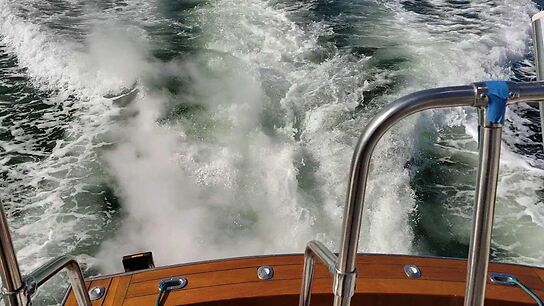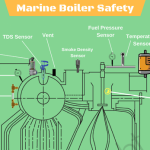Marine Engine
Volvo Penta marine engines have been around for some time and are still a popular choice for sailing boats and cruisers. They do however have inherent problems of being hard to start from cold and when started, smoke.
There are a number of causes of these problems, depending on the color of the smoke, and there is plenty of advice on the Internet, if you know where to look.
This is an article in Marine Engineering about cold start smoke problems with Volvo Penta marine engines. We begin with an overview of the Volvo Penta marine engine.
Overview of the Volvo Penta Marine Engine
This company started out as many did, with a workshop and foundry producing various engineering and domestic products. It was founded in 1868 and was based in Stockholm.
The early 1900’s saw an expansion into steam engines and water turbines for hydro power plants. However it was the amalgamation with another Stockholm engineering company of Fritz Egnell that led to their first engine that they named Penta. Egnell bought the company and renamed it Pentaverken and continued to produce marine engines, both inboard and outboard.
In the 1920’s Penta was approached by Volvo to design an engine for their auto. Penta obliged with a four cylinder side valve engine and became a subsidiary of Volvo in 1935.
To date Volvo Penta has produced some novel designs including the “pod drive” system and counter rotating props; their conventional marine engines are still being supplied to numerous prestigious boat builders.

The Causes of Cold Start Smoke Problem with Volvo Penta Marine Engine
Cold start smoke is common with most engines; however if the smoke persists after the engine has warmed up, then there could be a problem. An investigation into the cause is advisable. There are three distinct colors of persistent exhaust smoke, each telling their own story on the engine’s condition, and we shall examine these below.
White Smoke
Slow Cranking Over
· Lazy starter Motor
· Marine Batteries not charged fully or require replacing
Water
White smoke appears as steam and can indicate that there is water getting into the combustion system. A quick and easy check is to cup your hands around the exhaust and smell it. If it smells of oil then it is not a water problem; if no smell of it then it is water associated. Water can enter the system through a blown cylinder head gasket, a warped/cracked cylinder head, or a cracked block.
Low Compression
Low compression can be caused by numerous faults and although it does not lead directly to overheating, it does effect performance and results in white smoke and unburnt fuel exiting in the exhaust gasses. If low compression is suspected it is best to carry out an engine compression check to confirm if it is prevalent in one particular cylinder or if all cylinders are running with low compression.
Incorrect Operation of Fuel Injectors or Carburetor
Some modern Volvo Penta Marine Engines have fuel injectors and these should also be checked, preferably by an engineer. The older models have carburetors and although these give little trouble, the main jets, O-rings, and gaskets can become worn allowing excessive fuel to enter the engine. The carburetor is easily stripped and worn parts replaced.
Black/Gray Smoke
Poor Quality Fuel
Most gas supplies are now regulated, but if the fuel has been lying in the boat gas tank over winter, it may have become contaminated. Also only recommended boat marina gas suppliers should be used to supply the boat fuel tanks.
Excessive Fuel Supply
Almost all black/gray smoke is caused by excessive fuel supply combined with restricted air supply. The causes of excess fuel we have dealt with in the above section.
Inadequate Air Supply
This is mostly attributable to the air filter condition- a blocked air filter reducing the combustion air supply.
Exhaust Back-Pressure.
This can be caused by carbon build-up on piston crowns/valve gear or a kinked exhaust pipe.
When I was a young lad at sea as an engineer on oil tankers, we engineers used to get regular calls from the bridge reporting black smoke emitting from the funnel, whilst discharging oil in port. This occurred mostly on steam ships and meant a trip to the boiler room to check and adjust the fuel/air ratio at the burners. This was mainly due to the stopping/starting of discharge pumps that were steam turbine driven.
Blue Smoke
Lube-Oil
Blue smoke is invariably caused by the burning of lube-oil that indicates worn bores, or worn/broken piston compression or scraper rings. Worn valve guides can also be responsible through allowing valve gear lube oil to pass into the engine combustion chamber. All these components can be replaced and it is better to replace them all at the same overhaul.
So there we have it; the problems associated with smoke emission on cold starting.
Problems in Cold Starting Volvo Penta Marine Gasoline Engines
Reading reports on the Volvo gas engine, there seems to be a cold start problem. This sounds like an ignition problem. In the old days I used to renew plugs, points and condenser on my uncle’s boat every year at the start of the fishing season. I would then give the whole system a thorough clean and degrease the leads and distributer before coating them with and anti-condensation/damp spray. Pretty basic stuff, but the engine gave little trouble, the boat being used two or three times a day carrying about ten passengers on fishing trips.
With today’s modern marine engine’s computerized electrics and electronic ignition, you would think that the ignition system would be pretty reliable, but dampness will always be a factor. I am sure that a damp-proof spray would still be applicable, but check the engine manual first.
The generator, batteries, and starter motors should also be checked at least once a year as a slow crank turn-over is a cause of hard start.
I noticed during my research into the Volvo Penta engines that when some were hard to start, a squirt of ether into the air filter was recommended. I advise strongly against this although as a last resort I have used it myself- but only on one particular engine. I was Third Engineer at the time and the ship was in dry-dock in Govan, a port on the River Clyde.
I was due to have the ships lifeboat surveyed. The engine was a two cylinder Petter diesel and a pig to start, endeavoring to break your wrist when you dropped the decompresses.
Anyway, the Bosun and I checked the lifeboat supplies and I tried the engine with usual result so I gave it a squirt of Quick-Start and away she went. I warmed it up nicely, shut it down then awaited the Ships Surveyor who, when arrived, rechecked the supplies and asked me to start the engine. I turned it over dropped the de-compressors and away she went like a Swiss watch.
The Chief was along with the surveyor and he invited the Bosun, Surveyor and self to his cabin for a dram. I was feeling pretty cocky until the surveyor said he hoped I had enough Quick-start left to start the engine in the Atlantic – if we had to abandon ship! Obviously he smelt the ether.
After talking to the Petters representative in Glasgow, he recommended new fuel injectors, piston rings, O rings in the fuel pump and overhaul of valve gear. I spent the next few days stripping the engine, grinding in the valves and rebuilding it with the new parts.
I primed the fuel lines, cranked her over a few times and away she went- under her own steam, so to speak. I never had any more bother with that engine, but also never found out what the cause was; maybe it was a combination of faults that were rectified by the overhaul.


